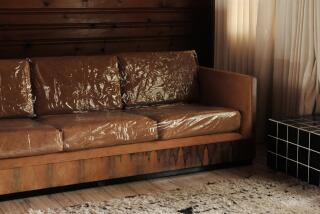Patio Cushions Are More Durable, Varied and a Lot Less Green
- Share via
In the old days, before the advent of high-tech, weather-impervious fabrics, the decision for those in the market for outdoor cushions was pretty simple: Buy the green, tufted canvas over a stuffed-cotton pad, or go wild and pick the green-and-white stripe.
And the vow you made was always the same too: This summer, you would pull your new cushions inside to protect them from the bright sunlight when not used. But year after year, whatever you chose seemed to become faded by summer’s end.
Nowadays, the outlook is brighter. Many cushions are made of industrial-strength, solution-dyed acrylic that can stand up to the rigors of outdoor life as well as a good end-of-summer scrubbing. And some companies feature hundreds of colors and patterns, including damasks, jacquards and other weaves associated with material that’s meant to live indoors.
Pick a piece of outdoor furniture from such established lines as Brown Jordan or Lane Venture and you’ll be presented with a thick ring of swatches from which to make your cushion choice.
“Outdoor fabrics have become so much more upscale with the acrylic yarns and the combination blends of fabrics,” says Becky Sturdivant, vice president of sales and marketing at CFI, a national supplier based in Sarasota, Fla. CFI has branched out to sell outdoor furniture and umbrellas in addition to cushions. “People are now trying to decorate their patio around the inside of their home. They’re taking the inside out,” she says.
Weather-resistant fabrics aren’t really all that new. Industry leader Sunbrella, a division of Glen Raven Custom Factories, has been producing these solution-dyed acrylics since the early ‘80s.
“It took a while for people to understand that you could have something that felt as good and looked as good, but it could survive the outdoors,” says David N. Swers, product manager for furniture fabrics at Glen Raven. The Sunbrella folks helped turn that opinion around by pointing out products that were made with basically the same fabric, including boat covers, awnings, convertible tops and umbrellas. “Lots of people had awnings above their shops or had seen a marina filled with our bright blue boat covers, and that gave people a level of comfort.”
The basic difference in the newer fabrics is that the color is put into the yarn as it is formulated. “The color isn’t poured on or added like a dye on top,” says Swers. “It’s locked into the fiber.” Some can even be washed with mild bleach solutions without fading the color.
High-performance fabrics add to the cost of cushions. Smith & Hawken, for example, sells a simple, double-piped chair cushion fashioned from a variety of Sunbrella fabrics for $60 apiece--the cheapest cushion available from its catalog and retail sources. A classic chaise cushion goes for $220.
Or you can just buy the fabric. Ethan Allen stores, for example, carry fabrics designed for their new outdoor furniture collection.
With greater acceptance of the material has come greater daring as far as colors and patterns. “Now it’s our customers who are pushing for new looks and expecting more for their outdoor furniture,” says Swers. “That wasn’t always the case.”
They’ve even begun to buy less forest green, the color that Swers calls “the 800-pound gorilla.”
This summer, a lighter green has become more popular than the old forest green. Earth tones such as taupe and terra cotta have also been hot.
(BEGIN TEXT OF INFOBOX / INFOGRAPHIC)
Durability Is in the Details
Becky Sturdivant of CFI in Sarasota, Fla., offers tips on buying cushions that will stand up to outdoor use:
* Ask about qualities that might not be immediately visible: What’s the number of stitches per inch in every seam? The more the better.
* Look for tight weaves or more yarn per square inch. Those are costlier but provides a more-durable fabric.
* Thread that contains high ultraviolet pigments--the kind used for car paints--helps cushions withstand the elements.
* Ask if the corners are hand-stuffed. This ensures that the foam and/or Dacron stays smooth and full, and keeps its shape.
* Look for ties with a finished rather than a raw edge. They’ll last longer and give your cushions a more-tailored look.
--Washington Post

